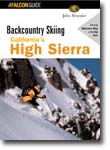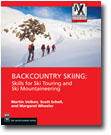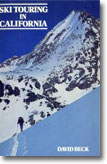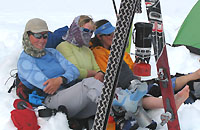Recommended Reading:

by John Moynier
Available at The Back Country

by Martin Volken, Scott Shell and Margaret Wheeler
Available at The Back Country.

by David Beck
Available at Amazon
By: Bela G. Vadasz
Many ask, "how can a one liter water bottle possibly be enough?"
Camp Drinker
Think of hydration, especially on a multi-day trip, to be on a 24-hour. basis. It's important to adopt the practice of becoming a camp drinker, not just a trail drinker. In other words, drink a lot when you're not traveling as well. If we create a quota (4 liters per day), on a 24-hour basis, think of drinking a lot during the 16 hours you're not traveling as well as the 8 hours or so you are traveling.
Start the day hydrating early and it's surprising
 how long you can go until your first drink from your water bottle. Begin with at least 1 liter of water, maybe a liter and a half. Hot tea and instant coffee count, even though they are considered a diaretic. You should use a hard bottle. It's easier to ration the water along the way as you can see how much you have left. If you use a hydration bladder, you'll need to carry a hard bottle as well to let boiling water cool before putting it in your soft bladder. With good pacing, we consistantly travel about an hour, then stop for about 10 minutes. So, there is always time to have a drink. Bladders are often problematic on high mountain tours.
how long you can go until your first drink from your water bottle. Begin with at least 1 liter of water, maybe a liter and a half. Hot tea and instant coffee count, even though they are considered a diaretic. You should use a hard bottle. It's easier to ration the water along the way as you can see how much you have left. If you use a hydration bladder, you'll need to carry a hard bottle as well to let boiling water cool before putting it in your soft bladder. With good pacing, we consistantly travel about an hour, then stop for about 10 minutes. So, there is always time to have a drink. Bladders are often problematic on high mountain tours.On spring tours with high angle sun and long days you can often add snow to your bottle
 each time you stop a have a drink. If you leave your bottle on the top of your pack, the warm rays of the sun help melt the snow. At rest stops, leave the bottle in the sun for melting. On most days, with the right technique you can easily stretch 1 liter into 2 while you're traveling.
each time you stop a have a drink. If you leave your bottle on the top of your pack, the warm rays of the sun help melt the snow. At rest stops, leave the bottle in the sun for melting. On most days, with the right technique you can easily stretch 1 liter into 2 while you're traveling. Open Water
When you run across accessible open water, flowing over rocks or in a streambed, consider it a bonus. Just stop, have a break and tank up. In the high country, consider iodine tablets or liquid tincture of iodine in a small dropper bottle to kill any bacteria or protozoa. If you mind the iodine taste, use absorbic acid to neutralize the iodine. An Emergen-C packet totally kills the taste and is good for you too!
Don't carry a filter on these tours, it's simply not worth the weight and fuss. Besides, we have never heard of anyone getting giardia from high spring run-off if chosen carefully with sources along the way from humanly traveled areas.
When you arrive at camp, start melting snow for drinking and re-hydrating right away. Bring the snowmelt to a boil first to kill any germs that might exist. Then drink at least a liter in the afternoon/early evening and 1 liter at dinner and through the night. As you can see, if you drink a liter of water in the morning, and two in camp in the evening, this means you only need another liter while on the trail to meet the minimum intake of four liters of liquid per day.
On big days, say more than 4,000' elevation gain, you can consider carrying a liter and a half during the travel time. This should be enough as long as there is lots of hydration during camp or hut time. That's what being a camp drinker is all about, lots of hydration during the down time makes a huge difference.
The Back Country: www.thebackcountry.net
Wild Snow: www.wildsnow.com
K2: www.k2ski.com
Garmont: www.garmont.com
Ortovox: www.ortovox.com
Patagonia: www.patagonia.com
Mammut: www.mammut.com